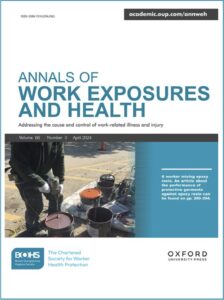Publications

Myotonometry in machinery operators and its relationship with postural ergonomic risk
Authors: Gabriela P. Urrejola-Contreras 1, Jose Miguel Martinez 2, 3, Monica Rodriguez-Bago 4, Elena Ronda 3, 5
Affiliations:
- Escuela de Ciencias de la Salud, Universidad Vina del Mar, Vina del Mar 2520000, Chile
- School of Public Health, University of Alberta, Edmonton, Alberta T6G 1C9, Canada
- Public Health Research Group, University of Alicante, San Vicente del Raspeig, Alicante 03690, Spain
- Physiotherapy Service, Department of Health Care, Medical and Health Care Services Division, MC Mutual Barcelona 08037, Spain
- CIBERESP, Madrid 28029, Spain
Journal: Annals of Work Exposures and Health - July 2024, Volume 68, Issue 6, Pages 605-616 (DOI: 10.1093/annweh/wxae028)
-
Field & Applications:
- Medical
- Occupational Healthcare
- Musculoskeletal health
- Balance / Postural control
- The main implication of this study lies in the on-site assessment of an industrial worker population, evaluating the risk derived from postural load when operating machines at the workplace using myotonometry.
- Myotonometry has the potential to noninvasively assess muscular biomechanical properties and alert if the obtained parameters of stiffness and muscle tone exceed physiological ranges, providing valuable information for the study of work-related musculoskeletal disorders associated with physical overload.
Objectives: To analyze the association between occupational ergonomic risk, personal characteristics, and working conditions with the biomechanical properties of stiffness and muscular tone in the paravertebral muscles of electric pallet jack and forklift operators in the industrial sector.
Methods: A total of 75 industrial sector machine operators were evaluated in 2021. Personal characteristics and working conditions were assessed through a questionnaire. Ergonomic risk was assessed using the Rapid Entire Body Assessment (REBA) method, and biomechanical properties of stiffness and muscular tone were obtained using the MyotonPRO device. Stiffness in paravertebral muscles was compared based on the operated machine and observed ergonomic risk. A multilevel linear regression model was employed to quantify the relationship, with mean differences and 95% CI calculated.
Results: Very high ergonomic risk was found in 75% of the electric pallet truck drivers. In this group with the highest ergonomic risk, an association between biomechanical properties and older workers was observed. Additionally, among electric pallet truck drivers, stiffness (mean difference 335.9 N/m, 95% CI: 46.4 (3.4 to 110.0), P < 0.05) and paravertebral muscle tone (mean difference 17.5 Hz, 95% CI: 1.4 (0.1 to 3.4), P < 0.05) showed statistically significant differences in the very high ergonomic risk category compared to the high-risk category. No significant differences were observed in any of the analyzed variables among forklift drivers.
Conclusions: Workers operating electric pallet trucks with very high ergonomic risk according to the REBA method and aged over 40 yr are associated with increased muscle stiffness and tone.
Keywords: biomechanical properties, ergonomic, industry, machinery operators, musculoskeletal disorder, workers
This study allows us to conclude that based on the biomechanical properties assessed using MyotonPRO in industrial workers, muscle stiffness and tone were affected by age and ergonomic risk related to posture. Specifically, individuals over 40 yr of age and the standing posture used in electric pallet jack operation were associated with increased muscle stiffness and tone.


